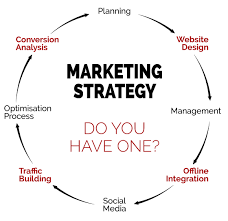
Marketing strategy is long-term, forward looking approach and an overall game plan of an organization or any business with fundamental goal of achieving a sustainable competitive advantage by understanding the needs and wants of the customers.
Its important to note that each marketing strategy should communicate the benefits and features of product. It can also communicate the overall value to the customers. This strategy communicates equality to the customers which is an advantage to the business. It creates goodwill in the target market. There are several marketing strategies as listed below;
Online Marketing

As commerce has propagated to the Internet, a new form of marketing has emerged. From online banners to those annoying pop ups, online marketers have attempted to get their customers attention any way they can. Most online strategic marketing efforts today are a mix of growth hacking strategies ( A/B testing taken to the max) and a variety of awareness tactics that drive attention. A very effective online marketer is the insurance company Geico who simply asks their users to enter their zip code for an instant quote on a better savings.
Offline Marketing
With mass adoption of the Internet, many companies are finding new ways of integrating offline marketing with new technologies to create more engaging customer experiences. The Coca-Cola company has create vending machines that invite customers to hug them. This continues to tie the Coca-Cola brand to the core emotion of happiness, but also invite customers to experience the real product offline.
Content Marketing
Write and publish content to educate potential customers about your products and services. For the appropriate businesses, this can be an effective means of influencing them without using direct selling methods.
Cause Marketing
Finding a causes both your customers and your company cares about can create magic for your business. This requires internal knowledge about what your organization cares about and who they want to help in the world. A good example of this is Toms Shoes. Instead of doing the traditional “buy one get one free” promotion, Toms built a strong customer following and reputation for giving back by giving away a free pair of shoes to someone in need for every shoe purchase made by their customers.
Relationship Marketing
Many companies focus on building relationships with their customers instead of always exclusively trying to sell them something (transactional marketing). Customers who love your brand more will also spend more money on your brand. Many traditional retailers have found this to be true.
Scarcity Marketing
In some markets it’s important to control how much product is available at one time. In many cases this is done because of the difficulty of acquiring raw materials or higher quality of the product. A company may choose to make their products accessible to only a few customers.
Word of Mouth Marketing

Word-of-mouth Marketing is the passing of information from person to person by oral communication. Customers are very excited to share with the world the brands they love. Many consumers find meaning in sharing stories of their favorite products and services. Word of Mouth is one of the ancient ways people learned about what to purchase. Modern marketers have learned how to create authentic word of mouth for their companies and the products they represent.
Call to Action(CTA) Marketing
CTA Marketing refers to methods of converting web traffic into leads or sales on websites using text, graphics, or other elements of web design. Conversion strategies help improve the percentage of online visitors who become customers or who join the mailing list.
Viral Marketing
Cult Brand marketers are constantly creating new business ideas that keep their products in the heart and minds of the global consumer. Each time a new product is created, customers have to be given a reason to dream about their future purchase. Sometimes marketers of Cult Brands hit on something so great that people can’t help but share with others. Getting your customers talking about your products and services is very important to growing awareness for your business.
Diversity Marketing
Develop a customized marketing plan by analyzing different customer segments based on cultural differences including tastes, expectations, beliefs, world views, and specific needs
Event Marketing
Creating events is a great way to drive sales. Customers often need a reason to shop and events can often offer the perfect reason.
Transactional Marketing
Driving sales can be challenging, especially for retailers that have to consistently sell products in high volume to consumers. In order to stay with the demands of investors, retailers have to encourage consumers to buy using coupons, discounts, liquidations, and sales events. High volume big-box retailers like Target are constantly running promotional events in order to get interested consumers into their stores.
Mass Marketing

Major corporations need to drive large numbers of purchasing of their products in order to survive and grow. While mass marketing may seem like a shotgun approach to marketing this is far from the truth. Big businesses spend big money in understanding big data–thats a lot of bigs!) This gives them an insight to where to place media for their potential national customers who buy their products and services. Walmart is an example of an effective mass market retailer. As the number one retailer in the world, they are very smart about their mass marketing efforts, often giving their customers a feeling of locality and warmth.
Undercover Marketing
Sometimes not telling everyone everything can become a great source of buzz. Think of a movie trailer that got you very excited to go see the movie. While not showing all the aspects of the movie, the advertiser can create enough intrigue to drive viewers to want to see more.
Seasonal Marketing
Seasonal events offers a great way to meet new consumers. Sometimes these events can be actual changes of weather or national holidays. For a retailer like Hallmark, Valentine’s Day represents a large portion of their business. By tuning into the various seasons that are important to your customers you can become more relevant in their lives.
Email Marketing
As soon as customers migrated into the online world, Internet marketers have attempted to collect and organize emails for potential prospects. Many business-to-business marketers depend on email marketing as a primary way to connect with customers.
PR Marketing
One of the most important marketing strategies is public relations. Many effective marketers work with the media to bring awareness to their products and the benefits their products offer. Also, in many cases where things go wrong, a good PR marketing strategy is vital.
Direct Marketing
Communicate directly with customers and prospects through mail, email, texts, fliers and other promotional material.
Direct marketing can be an effective way to reach consumers right where they live at home. While there is often a negative side to this approach (consumers don’t want to be bothered with a flurry of mail), many smart companies execute direct marketing well.
Inbound Marketing
Companies often have customers calling them for various reasons. This can present a great opportunity to sell customers additional products and services they currently don’t have. When business customers call to check their balances, the business bank Chase often takes the opportunity to ask if they are interest in a credit line, a 401 k plan, or a variety of other services the bank offers.
Outbound Marketing
Sometimes it’s important for companies to let their potential customers know they exist. By developing a list of prospects a company can begin to reach out to their individual target groups in order to find new customers. When Microsoft was selling their accounting software they often used outbound marketing to identify potential targets before trying to call the companies for an in-person meeting.
Freebee Marketing
Promote free give aways or sell your products and services sold at low rates to boost the sales of other related products or services.
Article Marketing
In industries where expertise is highly valued, articles can offer a powerful tool to showcase your knowledge and expertise. Some innovations are shared in the form of articles or white papers where technical information needs to be conveyed to specialized buyers. Amazon.com has dedicated part of their site for white papers on technical know-how on cloud computing. This is a very sophisticated form of marketing for specialized buyers.
NewsletterMarketing
A fun way to promote a business is to write a newsletter that highlights some of the newsworthy things that have happened for the organization. These newsletters create a sense of inclusion and participation with their members and has provided a key driver for their incredible growth.
Tradeshow Marketing
Many products have to be experienced to be bought. There are very few customers that will buy a new automobile without doing a great deal of research and test-driving the car first. Tradeshows are industry gatherings where customers are invited to come sample all that the industry has to offer. To introduce their new lines of products, Ford Motor Company spends a great deal of time setting up and operating their booth at the international consumer auto shows each year. These auto trade shows give reporters and consumers a chance to experience cars first hand.
Search Marketing
These days, when consumers have questions they often don’t ask their friends; they go straight for Google. In fact, Google is so good at answering our questions that millions of people daily search for their answers on this leading Internet search site. One does not have to look far to see the power of search marketing. Google has shaped the industry for many years now and has helped hundred of retailers grow their businesses. While many businesses used to advertise in their local yellow pages, as less and less consumer consult their local physical directory, this channel becomes increasingly less effective each year.
Niche Marketing

Finding a niche and filling it could be described as the secret recipe for growth in over-crowded marketplaces. Take the shoe business, for example. There is a great demand for shoes in the world and so many top companies have evolved to satisfy most of the immediate shoe needs in the marketplace. The shoe space might seem crowded, but shoe manufacturing company Vans noticed an underserved customer: the skater. By focusing on this niche market Vans has developed a thriving business.
Social Media Marketing
Social media sites like Facebook and Twitter offer a unique opportunity for savvy businesses willing to invest in customer engagement. Social media marketing is still in its infancy but is growing up rather quickly.
Cross-Media Marketing
Provide customers information through multiple channels like email, physical mail, websites, and print and online advertisements to cross promote your products and services.
B2B Marketing

Business-to-business marketing is a marketing practice of individuals or organizations (including commercial businesses, governments, and other institutions). It allows businesses to sell products or services to other companies or organizations that in turn resell the same products or services, use them to augment their own products or services, or use them to support their internal operations. International Business Machines is a well known B2B marketer. IBM’s business has grown because taking a very intelligent approach at marketing their products to other business and governments around the world.
Promotional Marketing
Promotional marketing is a business marketing strategy designed to stimulate a customer to take action towards a buying decision. Promotional marketing is a technique that includes various incentives to buy, such as:
- Contests: We all enjoy winning something for free. Contests offer an attractive marketing vehicle for small business to acquire new clients and create awareness.
- Coupons: According to CMS, a leading coupon processing agent, marketers issued 302 billion coupons in 2007, a 6% increase over the previous year. Over 76% of the population use coupons, according to the Promotion Marketing Association (PMA) Coupon Council. Coupons still work and provide an affordable marketing strategy for small business.
- Sampling: Try before you buy. Giving away product might appear profit-limiting, but consider how giving your customers a small taste can lead to a big purchase. Retail genius Publix supermarkets share samples of their award-winning key lime pie not because people question the goodness of the pie but to get their customers to buy more.
B2C Marketing
The ultimate goal of B2C marketing (business-to-consumer marketing) is to convert shoppers into buyers as aggressively and consistently as possible. B2C marketers employ merchandising activities like coupons, displays, store fronts (both real and online) and special offers to entice the target market to buy. B2C marketing campaigns are focused on a transaction, are shorter in duration, and need to capture the customer’s interest immediately. These campaigns often offer special deals, discounts, or vouchers that can be used both online and in the store.
Free Sample Marketing
Unlike Freebie Marketing, this is not dependent on complementary marketing, but rather consists of giving away a free sample of the product to influence the consumer to make the purchase.
